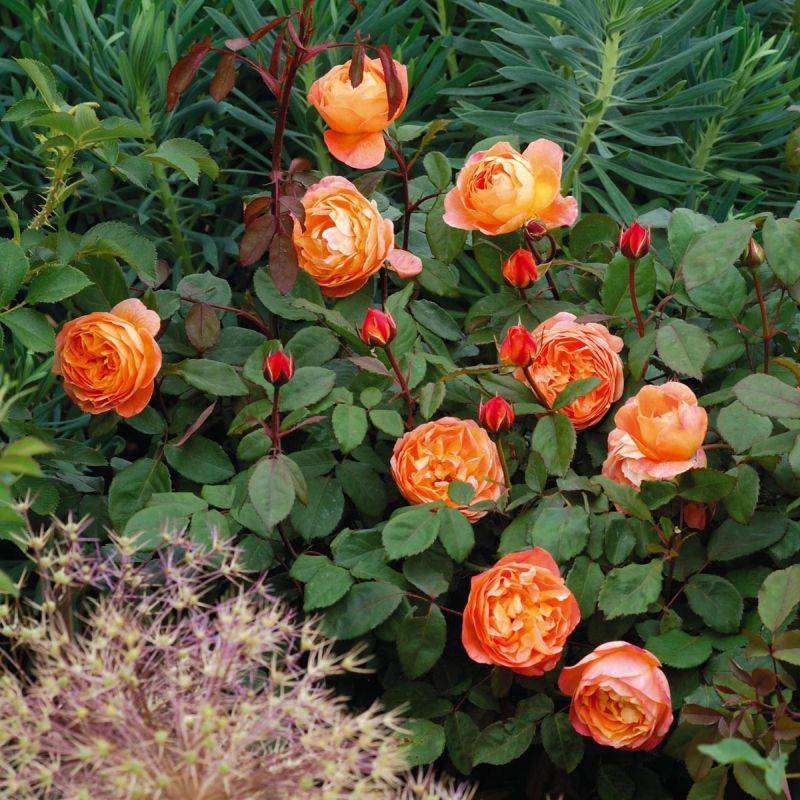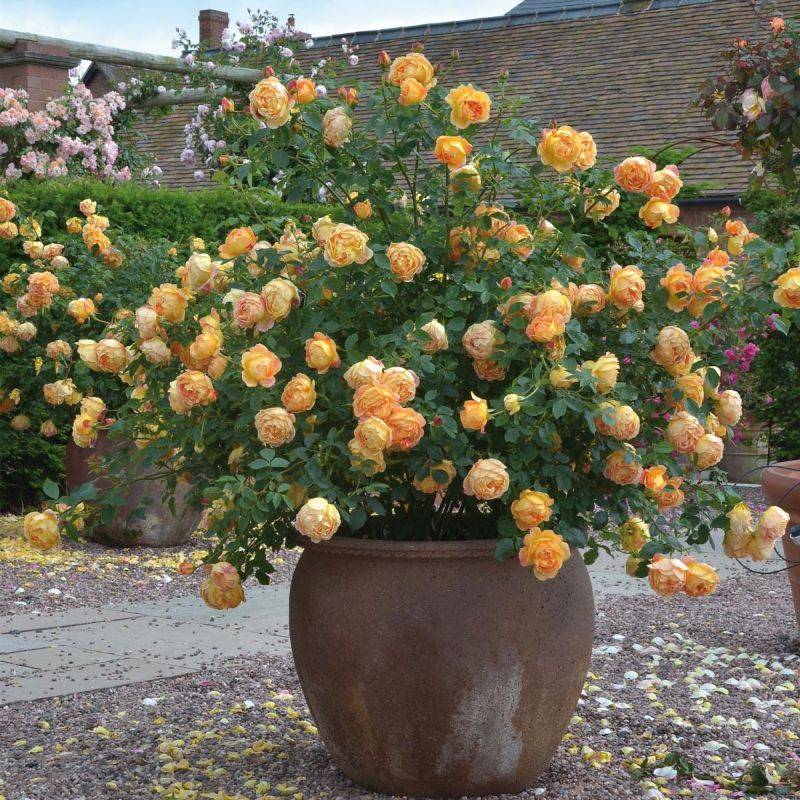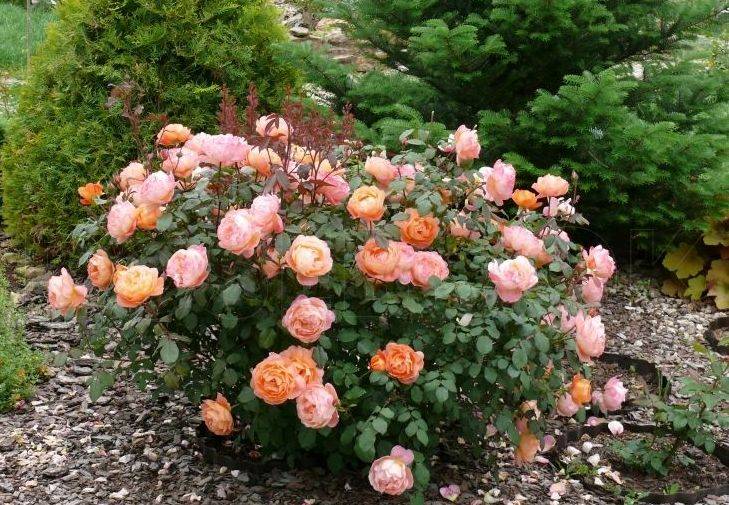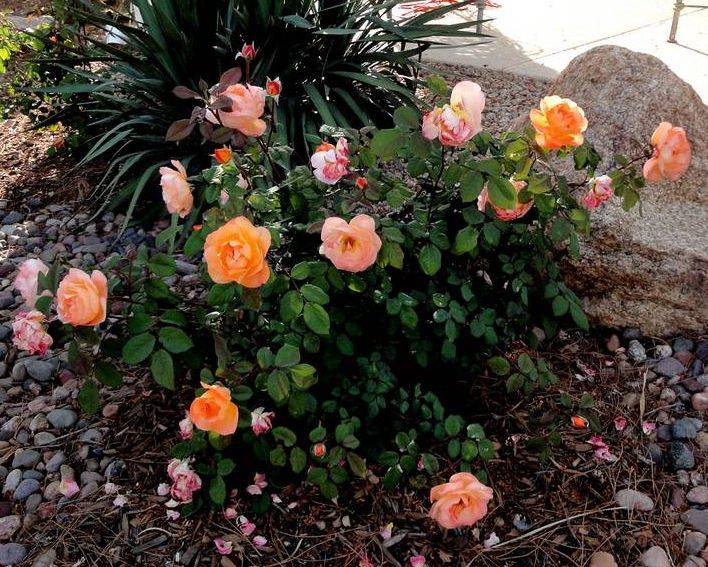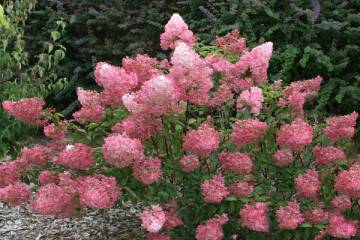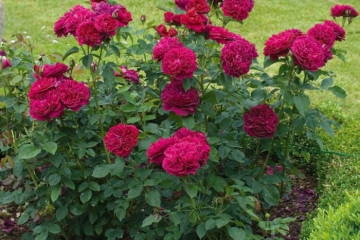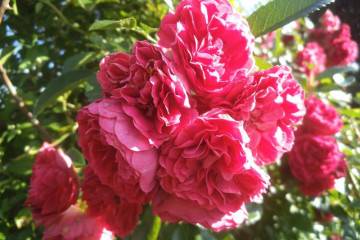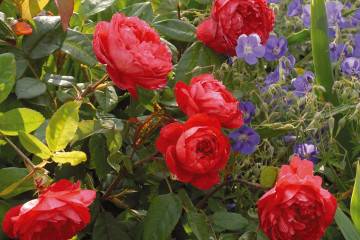Rose Lady Emma Hamilton (Lady Emma Hamilton) - variety description
Content:
Rose Lady Emma Hamilton is an unusual variety obtained through painstaking and complex breeding. The result of the efforts made by the breeders was worth it - the rose turned out to be beautiful, unpretentious, with lush and long flowering.
Rose Lady Emma Hamilton (Lady Emma Hamilton) - what kind of variety, history of creation
The "father" of the variety is the English breeder David Austin, year of creation - 2003. The flower is dedicated to the beautiful Emma Hamilton, the chosen one of Admiral Nelson.
Lady Emma Hamilton rose has the following description:
- bush height - up to 1.2 m, diameter - up to 90 cm;
- the leaves of a young bush are bronze; as it grows, they acquire a rich green color;
- inflorescences are cystic;
- flowers - double, up to 12 cm in diameter, in each bud there are about 45 petals;
- aroma - pleasant, rather strong, with fruity notes;
- color - changing, from red to tangerine.
Advantages and disadvantages of the variety
Rose Emma is loved by gardeners for a number of its advantages:
- flowering lasts the entire season, until the beginning of autumn;
- unpretentiousness;
- good frost resistance;
- strong immunity to diseases and pests.
The only drawback is the high price of seedlings.
Use in landscape design
An exquisite flower is planted on alpine slides and flower beds, in winter galleries, along paths. A rose on a trunk looks especially great.
Growing a flower, how to plant it in open ground
Disembarkation is quite simple, it will not bring any trouble to the gardener.
Emma rose Hamilton saplings are planted. Boarding times vary by region. In the northern regions - from April to May, or in early autumn. In the southern regions - the last days of March, early April.
Location selection
Hamilton prefers well-lit places without direct sunlight. Does not like the flower of strong wind and drafts. If the landing is planned near the house, it is necessary to place the bushes at a distance from the wall so that rainwater flowing from the roof does not fall on it.
How to prepare the soil and flower for planting
The soil is fertilized with manure or compost. The root system of the seedlings is examined - bad, damaged roots are removed. If clay prevails in the ground, sand is added. If the soil is sandy, dilute it with clay.
Planting procedure step by step
For a bush, you need to prepare a hole with a diameter of about 60 cm:
- At the bottom of the pit, drainage is made from expanded clay or small stone.
- The seedling is placed in the hole, the root system is straightened.
- The hole is covered with earth, watered at the root.
To increase the likelihood of successful rooting, it is recommended to place the seedling in water with a growth stimulant diluted in it a day before planting.
Plant care
Rose Hamilton is unpretentious. She needs proper watering, feeding and periodic pruning.
Watering rules and humidity
Humidity is moderate. Watering is carried out 1 time in 10 days, 1.5 - 2 buckets per bush. After each watering, it is recommended to slightly loosen the soil so that there is air access to the roots.
Top dressing and soil quality
The soil must be enriched with mineral elements. Fertilizers - mineral in summer and nitrogen in spring. Fertilizers are applied 2-3 times per season.
Pruning and replanting
The transplant is carried out in the spring, while maintaining a lump of old earth on the roots. Sanitary pruning. After flowering, wilted buds are removed. Damaged and weak branches are pruned in the fall. In the spring, it is necessary to cut off frozen branches.
At the first flowering of the bush, all buds are to be removed. Only in August, you can leave a few buds on a rose. This measure will help stimulate the active growth of the bush.
Features of wintering a flower
Although the variety is quite frost-resistant, for the winter, the bushes must be protected under a cover of spruce branches or non-woven material.
Rose bloom and dormant period
The rose blooms from early June to early September.
From October to early March, the rose is dormant. After flowering, it is necessary to remove wilted buds, if necessary, carry out sanitary pruning. In the spring, before the buds appear, fertilizers are applied. During the flowering period, the rose needs abundant watering and in the introduction several times during the feeding season.
What to do if it does not bloom, possible reasons
Lack of flowering can be caused by prolonged drought or abundant watering, lack of nutrients in the soil. To restore the strength of the bush, you need to adjust the care.
Flower propagation
You can propagate a rose by cuttings or grafting. The advantage of cuttings is the preservation of all the characteristics of the variety. Grafting is preferable in that the rose grown in this way has a strong immunity to diseases and resistance to different weather conditions.
Cuttings
Warm spring or early autumn is suitable for propagation by cuttings.
Cutting order:
- Cut off young, strong shoots, cut them into cuttings, each up to 10 cm long, several buds are required.
- A straight cut is made under the upper kidney, above the lower kidney - at an angle of 45 degrees.
- Dip the cuttings into a growth stimulator.
- Plant in nutrient soil, water, cover with plastic wrap or plastic bottle.
The cuttings are watered periodically.
Graft
Rose grafting is done in summer or winter.
Procedure:
- Prepare cuttings.
- On the rootstock, the plant where the grafting will be carried out, a cut is made on the root collar, it must be wiped with a clean rag.
- Cut off the bud from the cutting with a piece of bark under it.
- A T-shaped cut is made on the part of the root collar with a sharp knife.
- Connect the stalk with the stock, fix with foil, cover the grafting site with earth.
Diseases, pests and ways to control them
The rose is resistant to diseases. All that can happen to her is getting sunburn and root rot due to over-watering. If the roots are rotten, you need to remove the damaged roots and normalize watering.
Pests - aphids, spider mites. Treatment - treatment with soapy water, in advanced cases, insecticides are used.
Hamilton is a beautiful, unusual rose bush.The flower is unpretentious, resistant to different weather and pests. Growing and propagating a rose is within the power of anyone who wants to envelop their garden in the pleasant fruity aroma of blossoming buds.

